Fire Resistance of Ultra-High-Strength Steel Columns Using Different Heating Rates
Abstract
Featured Application
Abstract
1. Introduction
2. Methodology and Validation
2.1. Loading Elements under Different Heating Rates
2.2. Material Properties at Elevated Temperatures
2.3. Model Validation for CHS Columns under Fire
2.3.1. Elastic Buckling Analysis
2.3.2. Load Bearing Capacity at Room Temperature (GMNIA)
2.3.3. Nonlinear Structural Analysis at Elevated Temperatures
2.4. Model Validation for Hybrid Columns under Fire
2.4.1. Elastic Buckling Analysis
2.4.2. Load Bearing Capacity at Room Temperature (GMNIA)
2.4.3. Nonlinear Structural Analysis at Elevated Temperatures
2.5. Thermal Analysis
2.6. Thermo-Mechanical Analysis
3. Parametric Analysis of CHS Columns
3.1. Effect of the Load Level on the Critical Temperature
3.2. Effect of the Wall Thickness on the Critical Temperature
3.3. Effect of the Element Length on the Critical Temperature Using Different Heating Rates
4. Parametric Analysis of Hybrid Columns
4.1. Effect of the Load Level on the Critical Temperature
4.2. Effect of the Wall Thickness on the Critical Temperature
4.3. Effect of the Element Length on the Critical Temperature Using Different Heating Rates
5. Comparison and Discussion of the Results
6. Conclusions
Author Contributions
Funding
Institutional Review Board Statement
Informed Consent Statement
Data Availability Statement
Conflicts of Interest
References
- CEN fprEN 1993-1-1:2022; Design of Steel Structures—Part 1-1: General Rules and Rules for Buildings. CEN: Brussels, Belgium, 2021.
- Javidan, F.; Heidarpour, A.; Zhao, X.-L.; Minkkinen, J. Application of high strength and ultra-high strength steel tubes in long hybrid compressive members: Experimental and numerical investigation. Thin-Walled Struct. 2016, 102, 273–285. [Google Scholar] [CrossRef]
- Nassirnia, M.; Heidarpour, A.; Zhao, X.-L.; Minkkinen, J. Innovative hollow columns comprising corrugated plates and ultra high-strength steel tubes. Thin-Walled Struct. 2016, 101, 14–25. [Google Scholar] [CrossRef]
- Wang, F.; Liang, Y.; Zhao, O.; Young, B. Pin-ended press-braked S960 ultra-high strength steel angle section columns: Testing, numerical modelling and design. Eng. Struct. 2021, 228, 111418. [Google Scholar] [CrossRef]
- Neuenschwander, M.; Knobloch, M.; Fontana, M. Elevated temperature mechanical properties of solid section structural steel. Constr. Build. Mater. 2017, 149, 186–201. [Google Scholar] [CrossRef]
- Azhari, F.; Heidarpour, A.; Zhao, X.L.; Hutchinson, C.R. Post-fire mechanical response of ultra-high strength (Grade 1200) steel under high temperatures: Linking thermal stability and microstructure. Thin-Walled Struct. 2017, 119, 114–125. [Google Scholar] [CrossRef]
- Li, H.-T.; Young, B. Mechanical properties of cold-formed high strength steel at elevated temperatures. In Insights and Innovations in Structural Engineering, Mechanics and Computation; CRC Press, Taylor & Francis Group: Boca Raton, FL, USA, 2016; Volume 64, pp. 1022–1027. [Google Scholar]
- Qiang, X.; Jiang, X.; Bijlaard, F.S.K.; Kolstein, H. Mechanical properties and design recommendations of very high strength steel S960 in fire. Eng. Struct. 2016, 112, 60–70. [Google Scholar] [CrossRef]
- Farmani, M.A.; Heidarpour, A.; Zhao, X.-L. A distinctive approach to testing and modeling thermal creep in ultra-high strength steel. Int. J. Mech. Sci. 2021, 198, 106362. [Google Scholar] [CrossRef]
- CEN prEN1993-1.2: 2023; Eurocode 3: Design of Steel Structures—Part 1-2: General Rules—Structural Fire Design. CEN: Brussels, Belgium, 2023; pp. 1–97.
- Farmani, M.A.; Heidarpour, A. Development of design equations for ultra-high strength steel CHS columns under transient fire conditions considering thermal creep and axial restraint effects. Fire Saf. J. 2023, 136, 103756. [Google Scholar] [CrossRef]
- Farmani, M.A.; Heidarpour, A.; Woo, C. Thermal creep of hybrid steel columns comprising ultra-high strength steel tubes and stainless steel plates under transient fire conditions. Thin-Walled Struct. 2023, 185, 110540. [Google Scholar] [CrossRef]
- Madenci, E.; Guven, I. The Finite Element Method and Applications in Engineering Using ANSYS; Springer: New York, NY, USA, 2006. [Google Scholar]
- Piloto, P.A.G.; Khetata, M.S.; Ramos-Gavilán, A.B. Analysis of the critical temperature on load bearing LSF walls under fire. Eng. Struct. 2022, 270, 114858. [Google Scholar] [CrossRef]
- CEN EN 1363-1; Fire Resistance Tests—Part 1: General Requirements. CEN: Brussels, Belgium, 2020.
- CEN EN 13501-2; Fire Classification of Construction Products and Building Elements. CEN: Brussels, Belgium, 2009.
- ISO ISO 834-1; Fire Resistance Tests—Elements of Building Construction—Part 1: General Requirements. International Organization for Standardization: Geneva, Switzerland, 1999; p. 25.
- CEN EN 10219-2:1997; Cold Formed Welded Structural Hollow Sections of Non-Alloy and Fine Grain Steels—Part 2: Tolerances, Dimensions and Sectional Properties. Deutsche Industrie Norm: Berlin, Germany, 1997.
- Crisfield, M.A. An arc-length method including line searches and accelerations. Int. J. Numer. Methods Eng. 1983, 19, 1269–1289. [Google Scholar] [CrossRef]
- Fonseca, E.M.M.; Oliveira, C.A.M.; Melo, F.Q. Experimental Validation of a Theoretical Model in Thin-Walled Structures. Exp. Mech. (Port. Assoc. Exp. Mech.) 2002, 8, 41–48. (In Portuguese) [Google Scholar]
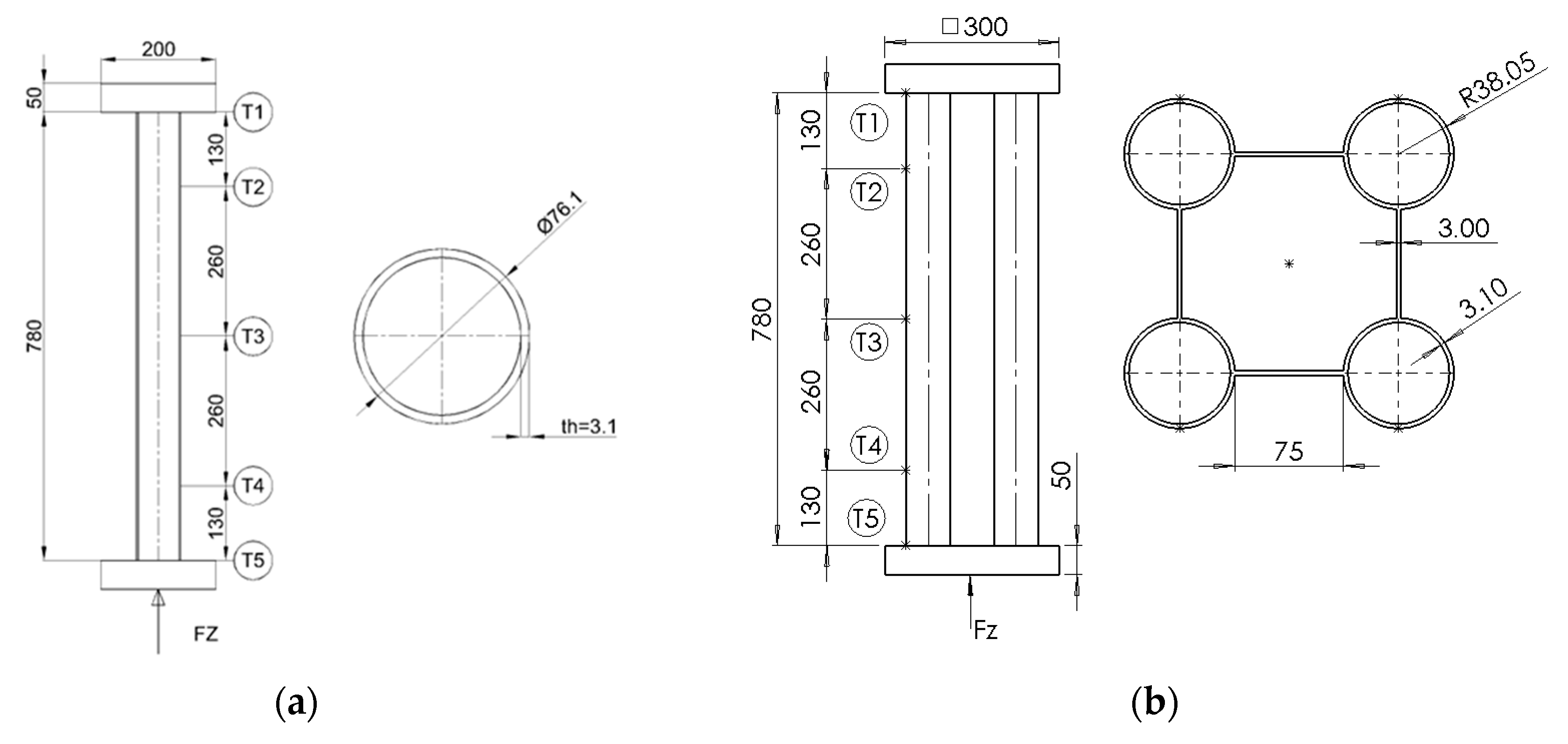
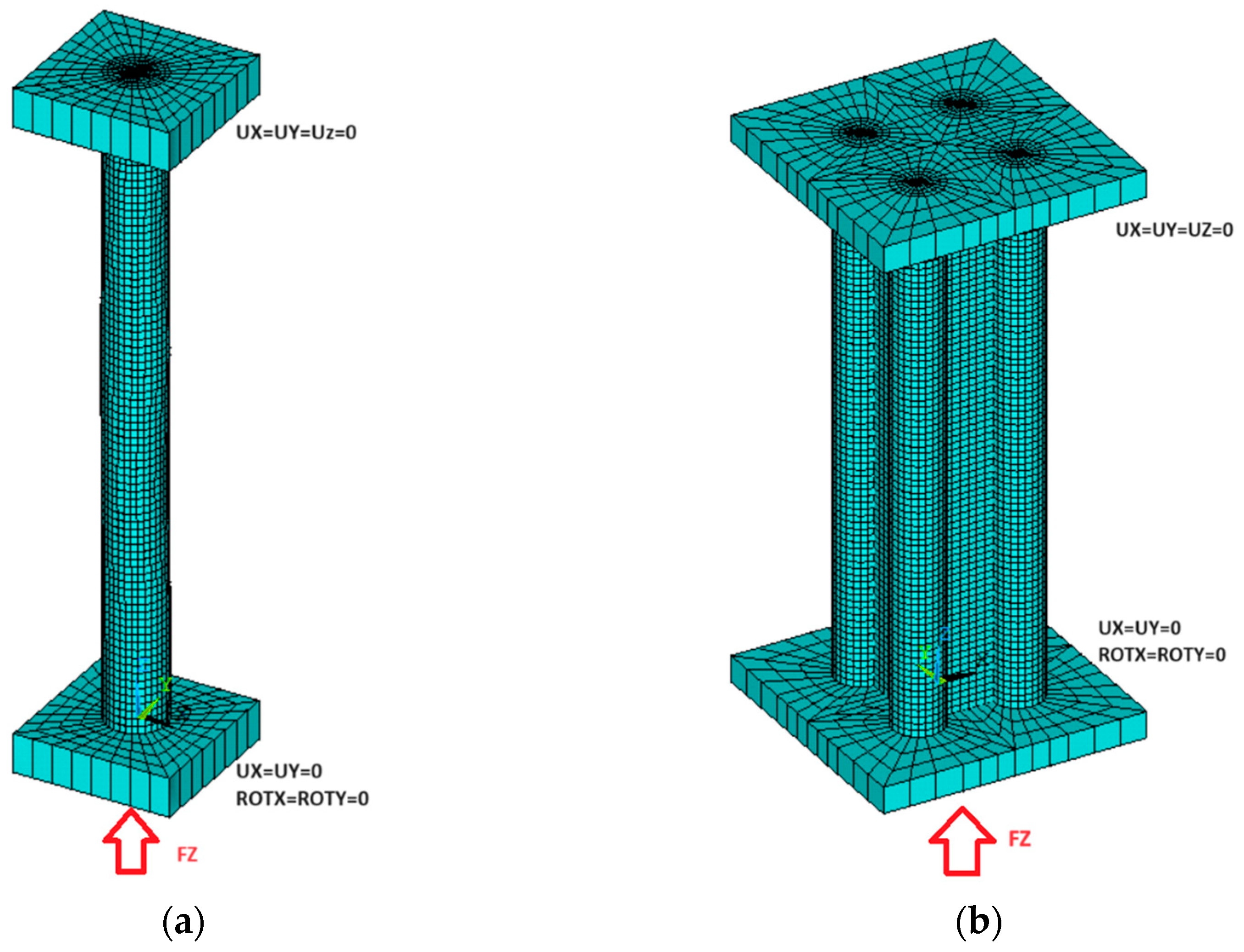
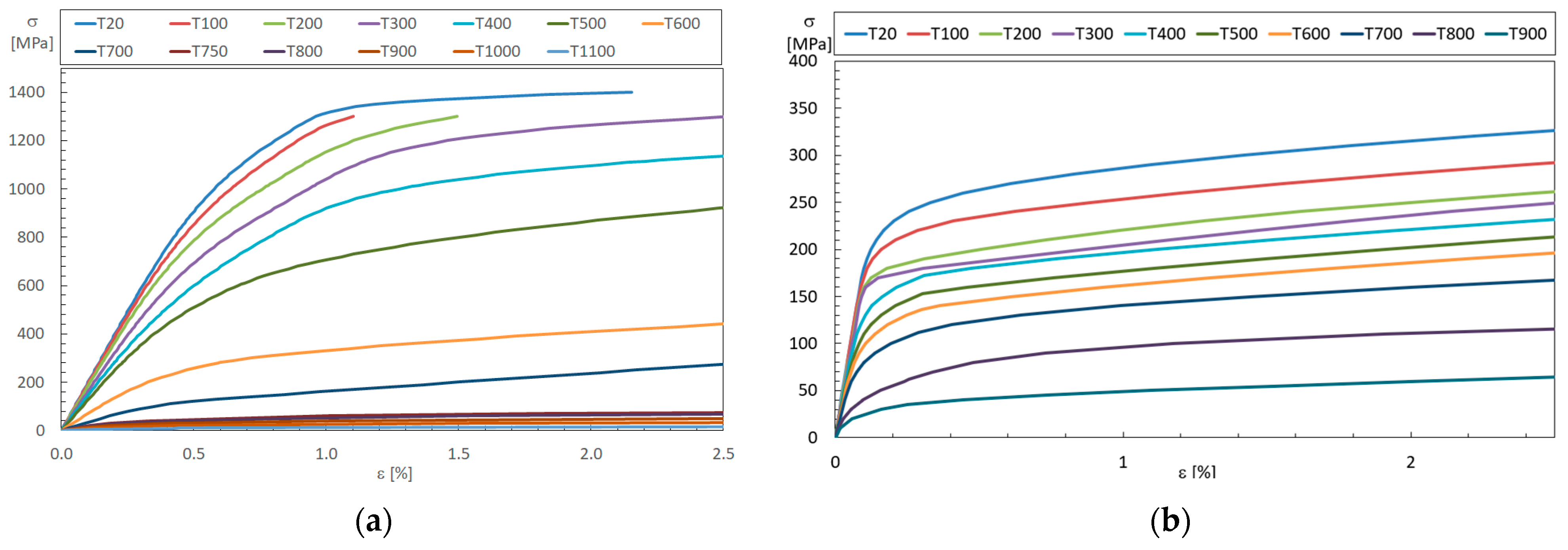
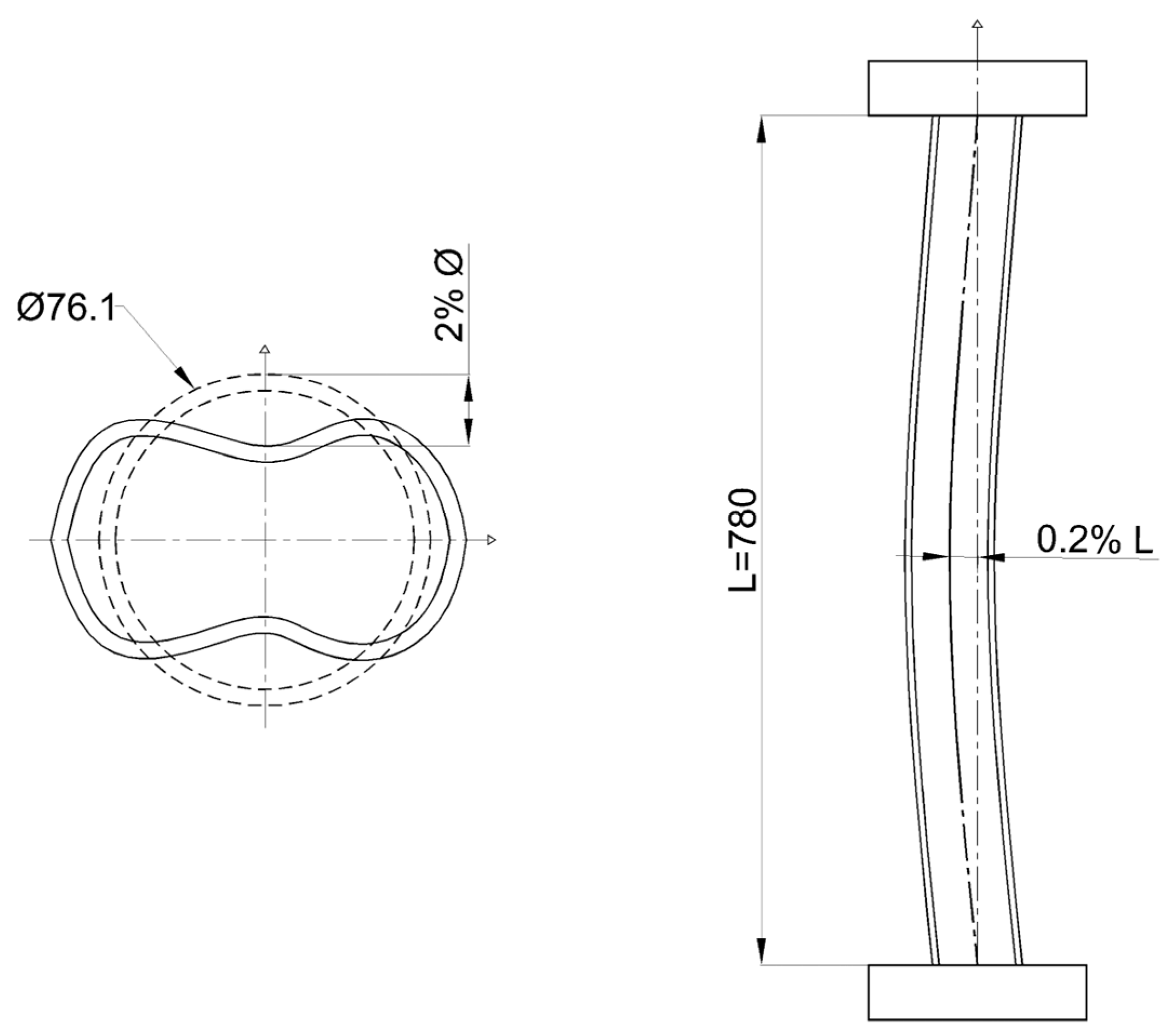
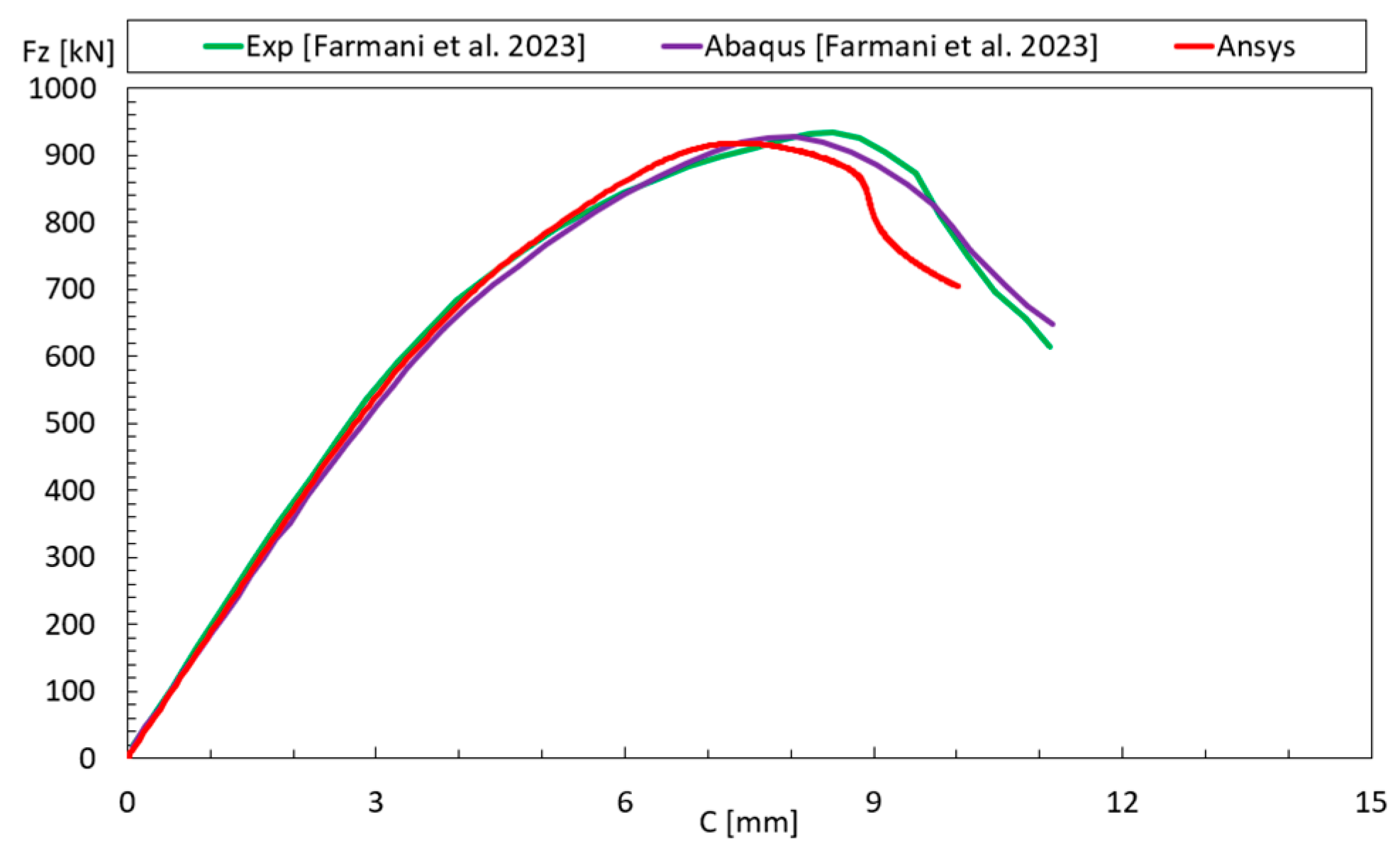


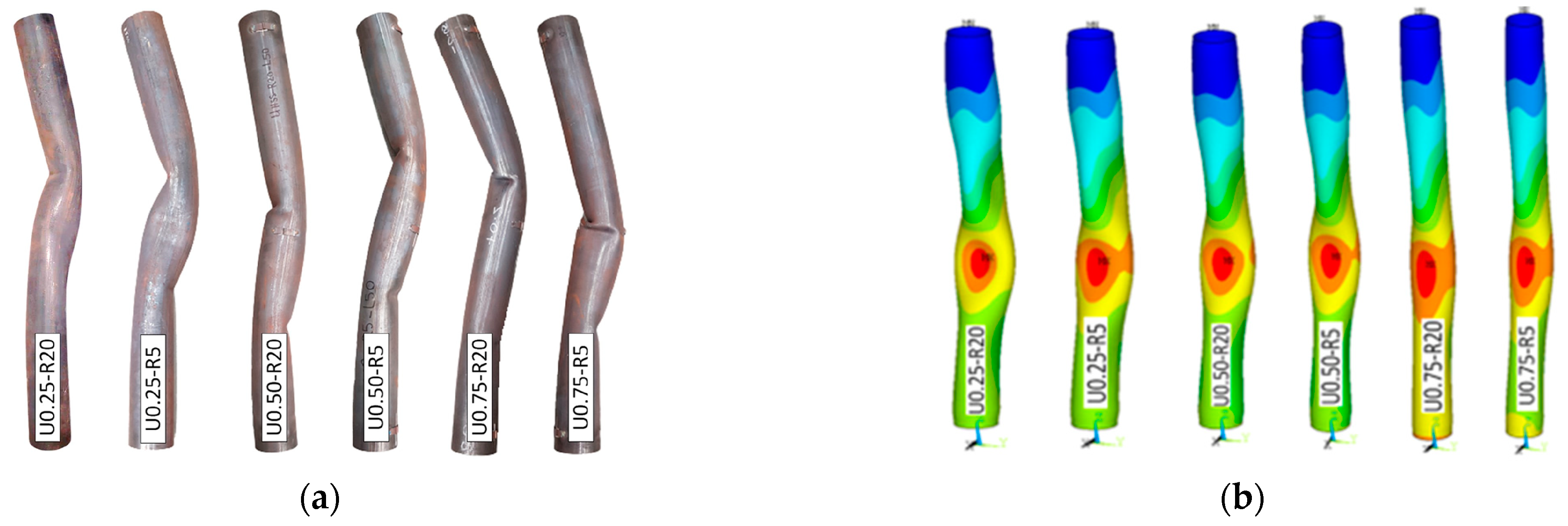


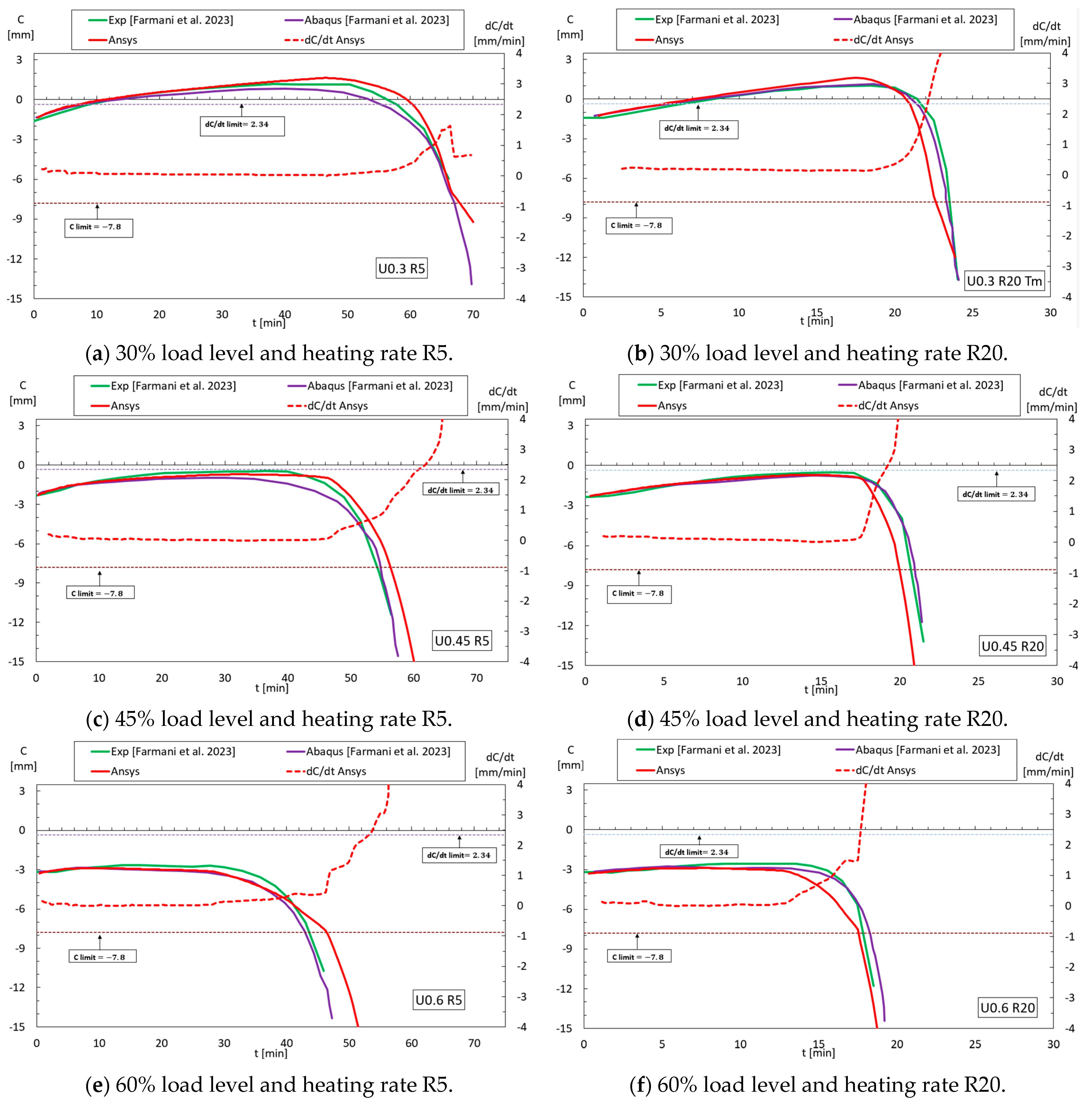
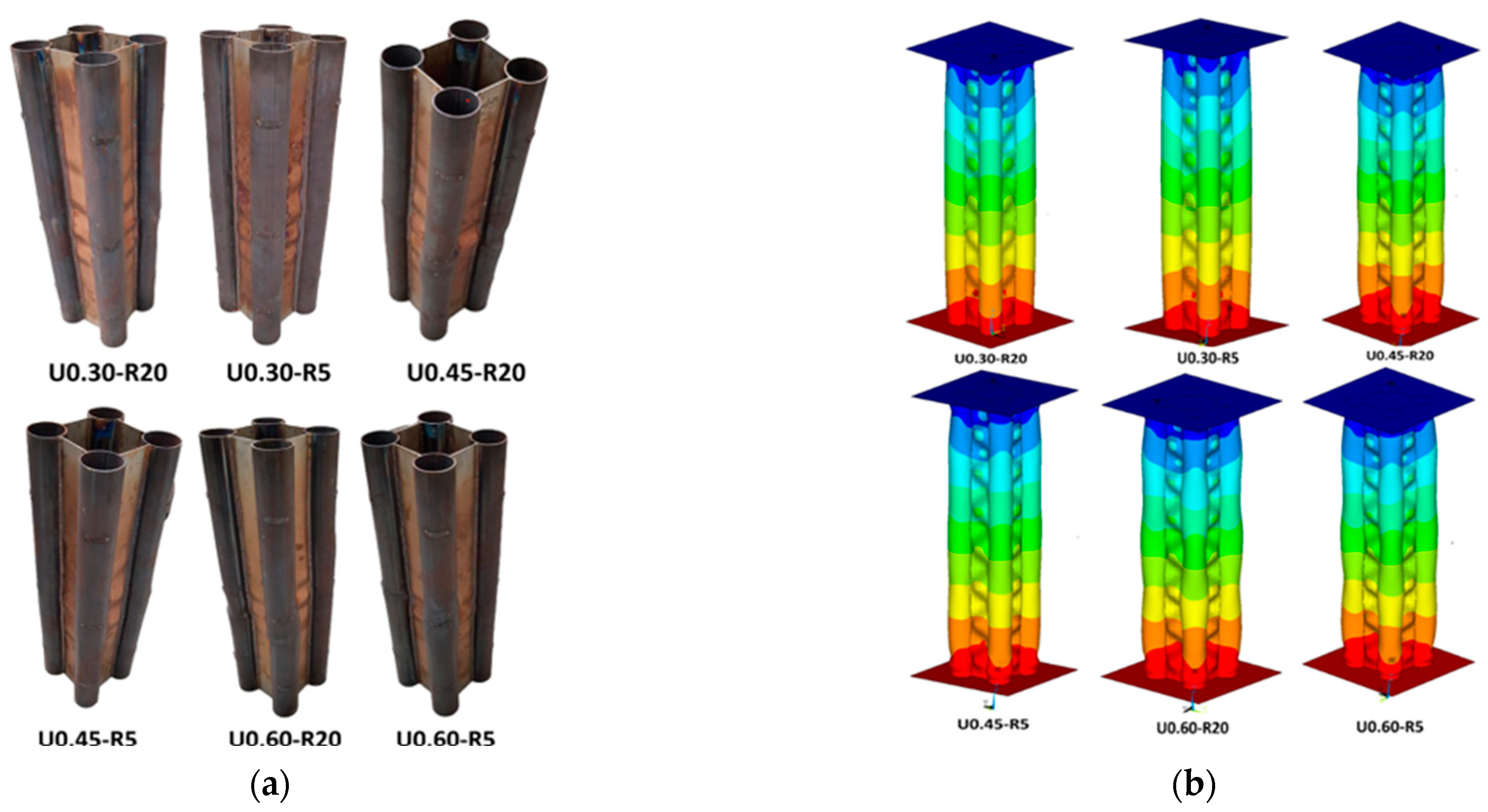

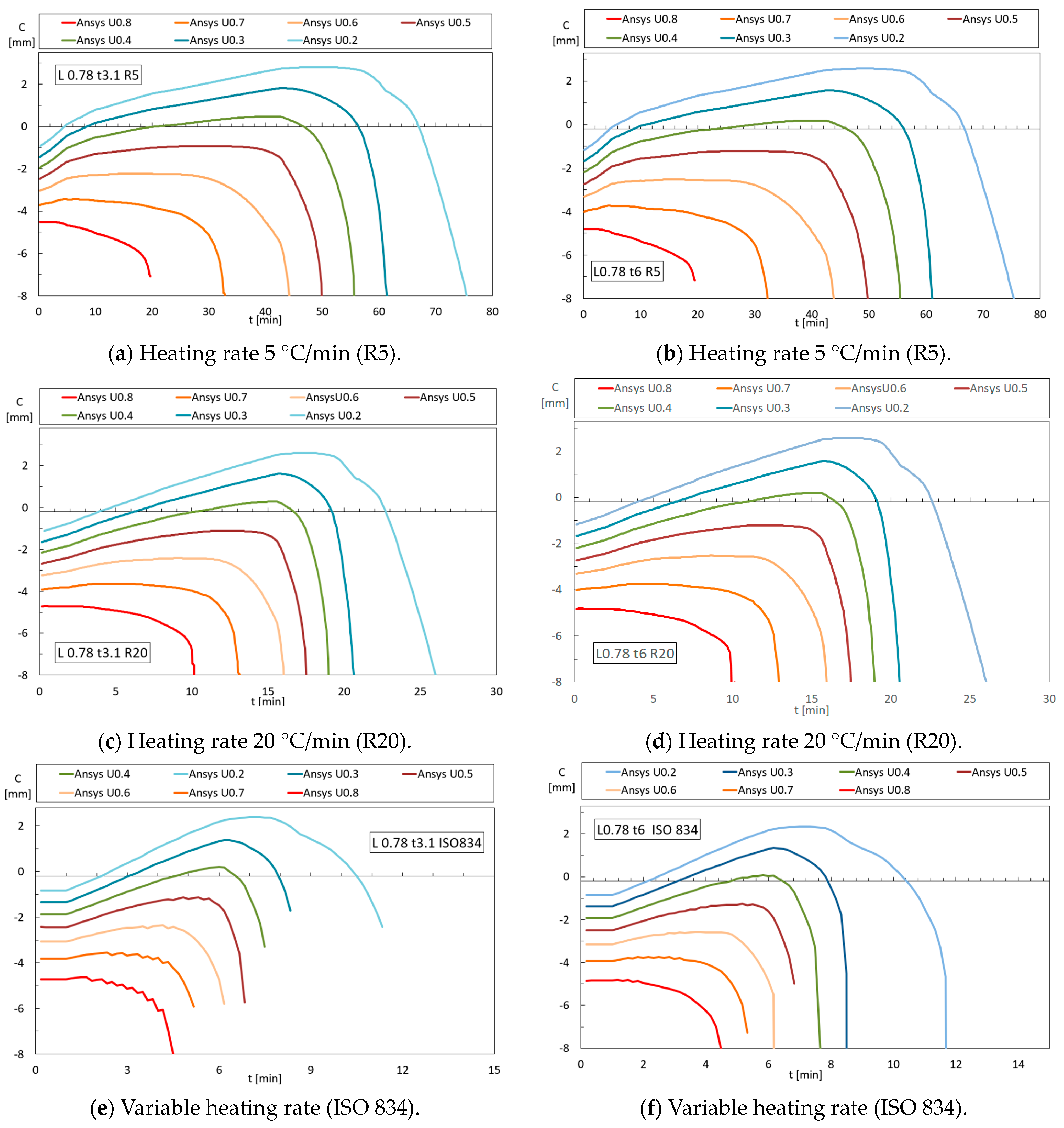
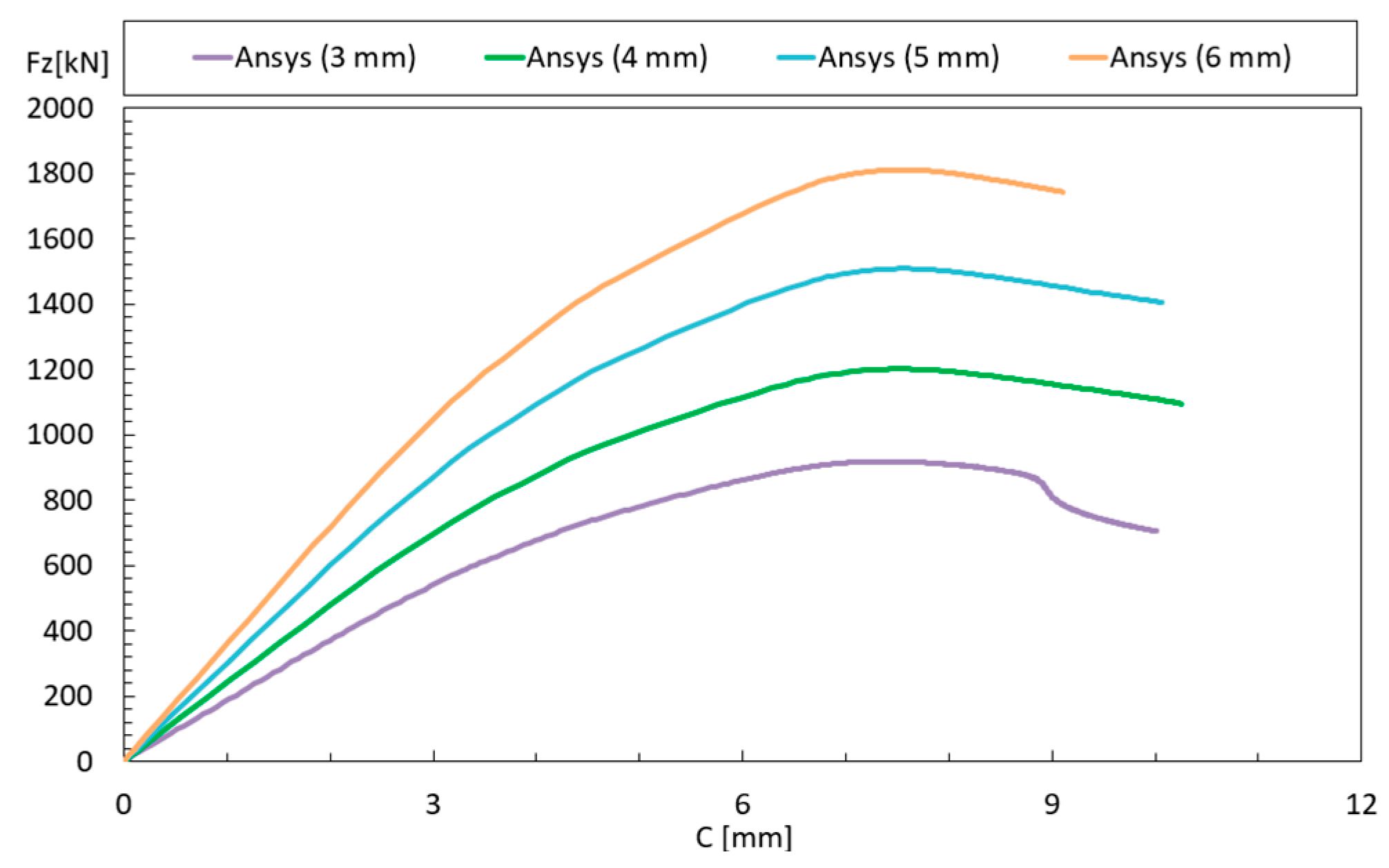
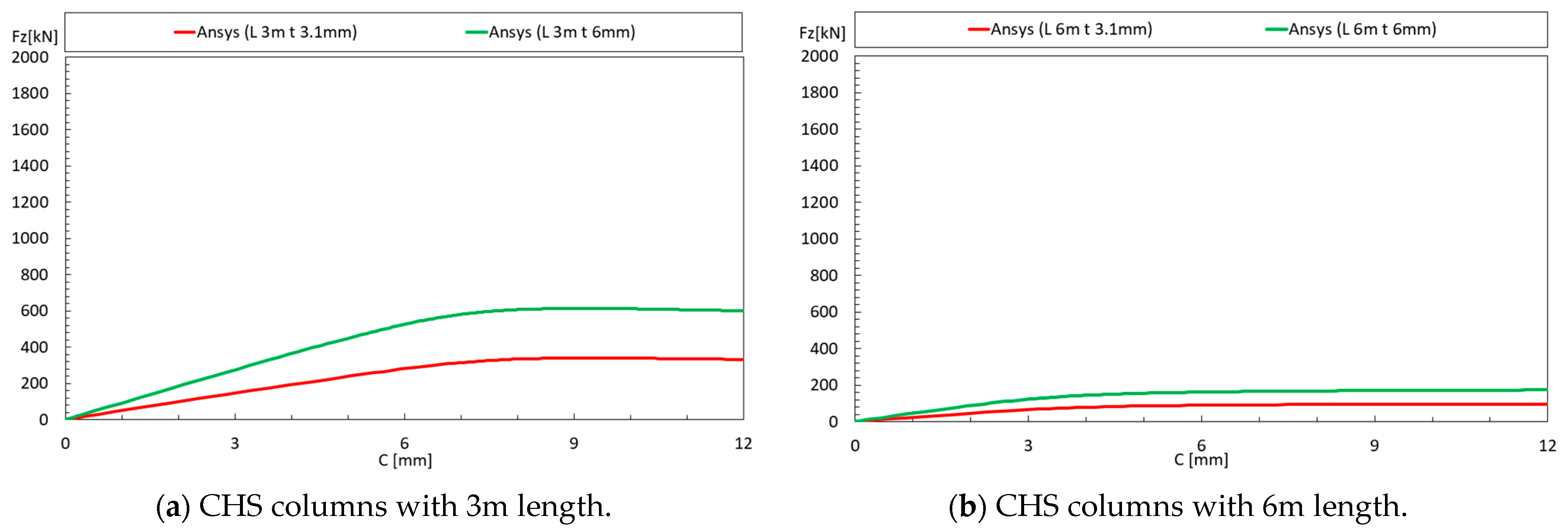
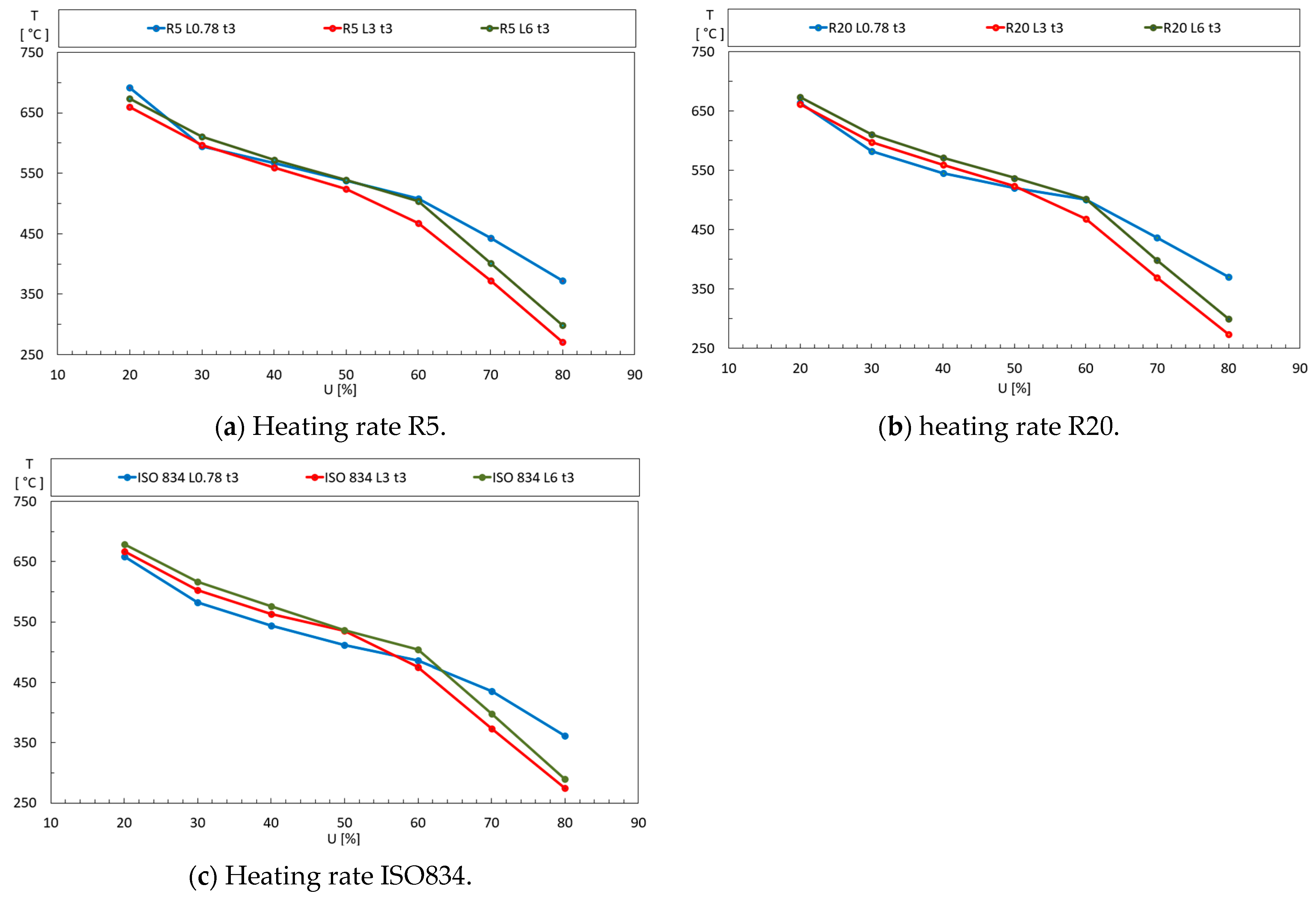
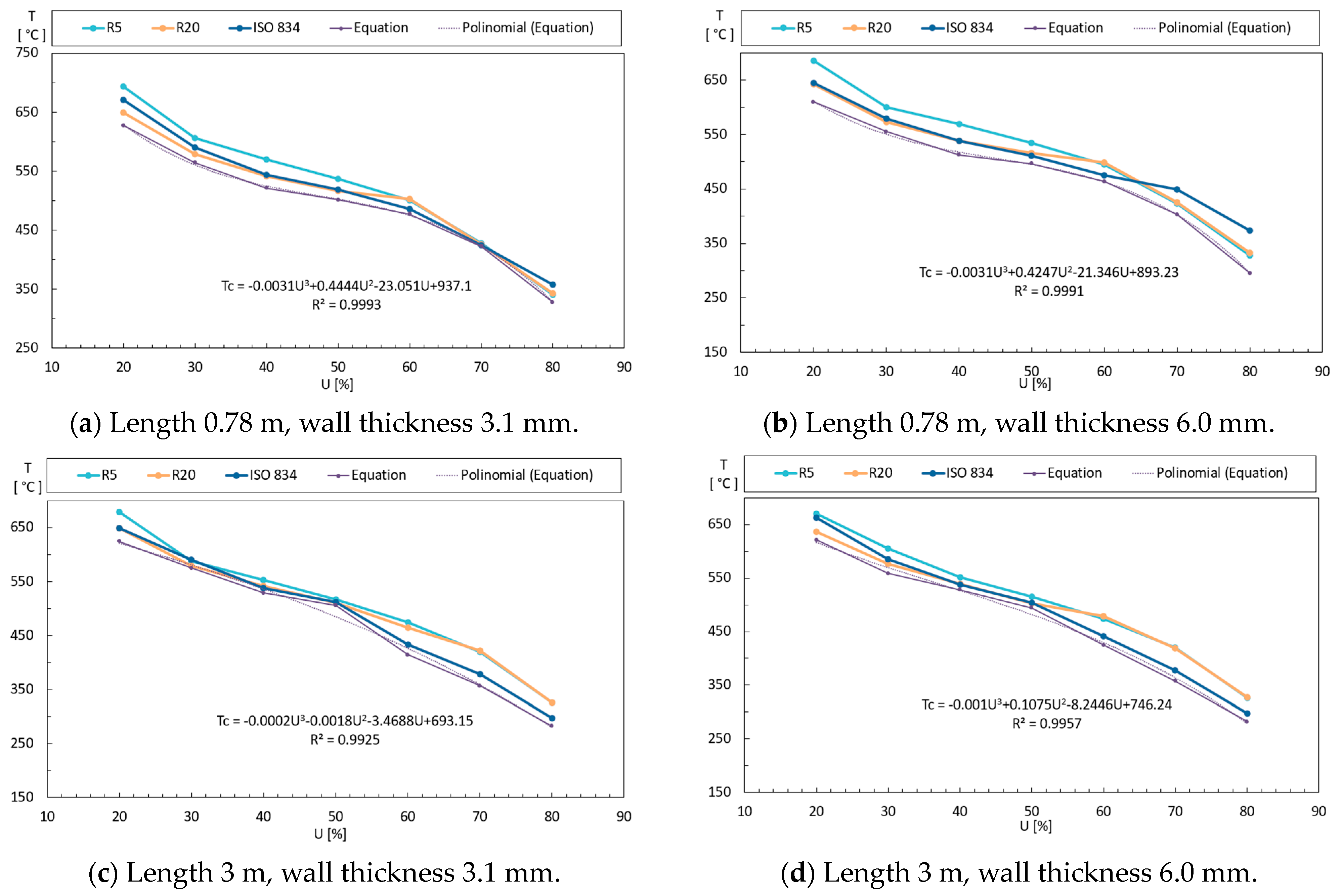
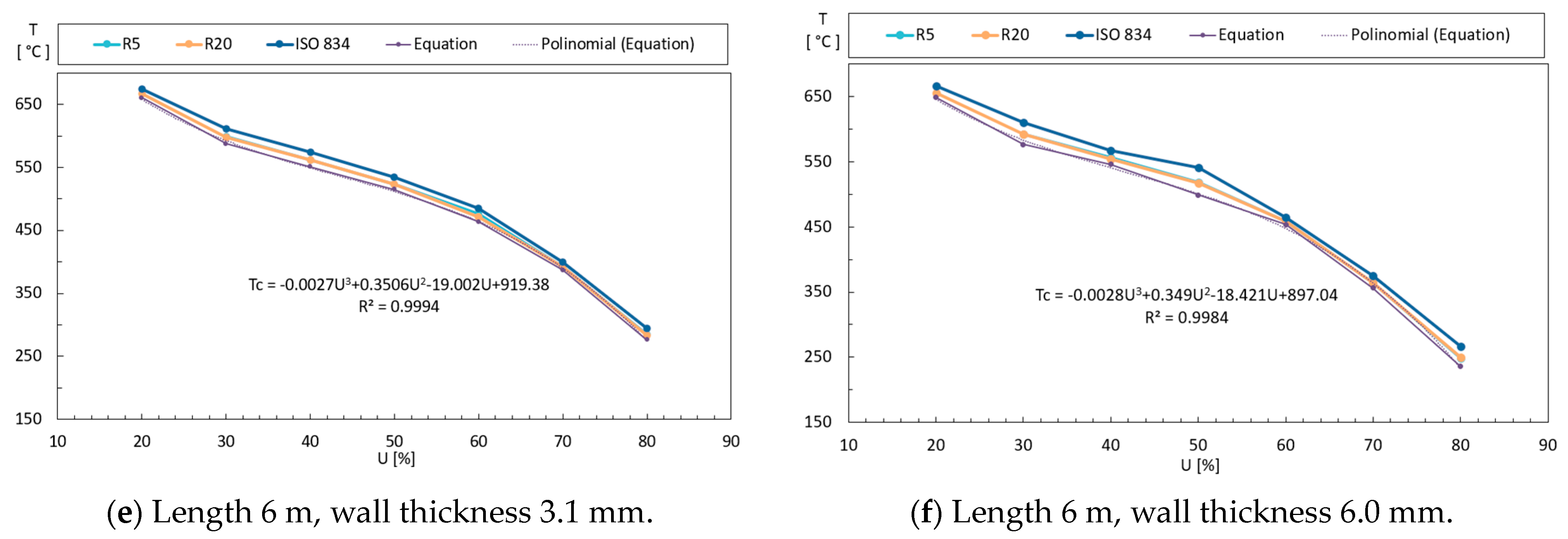
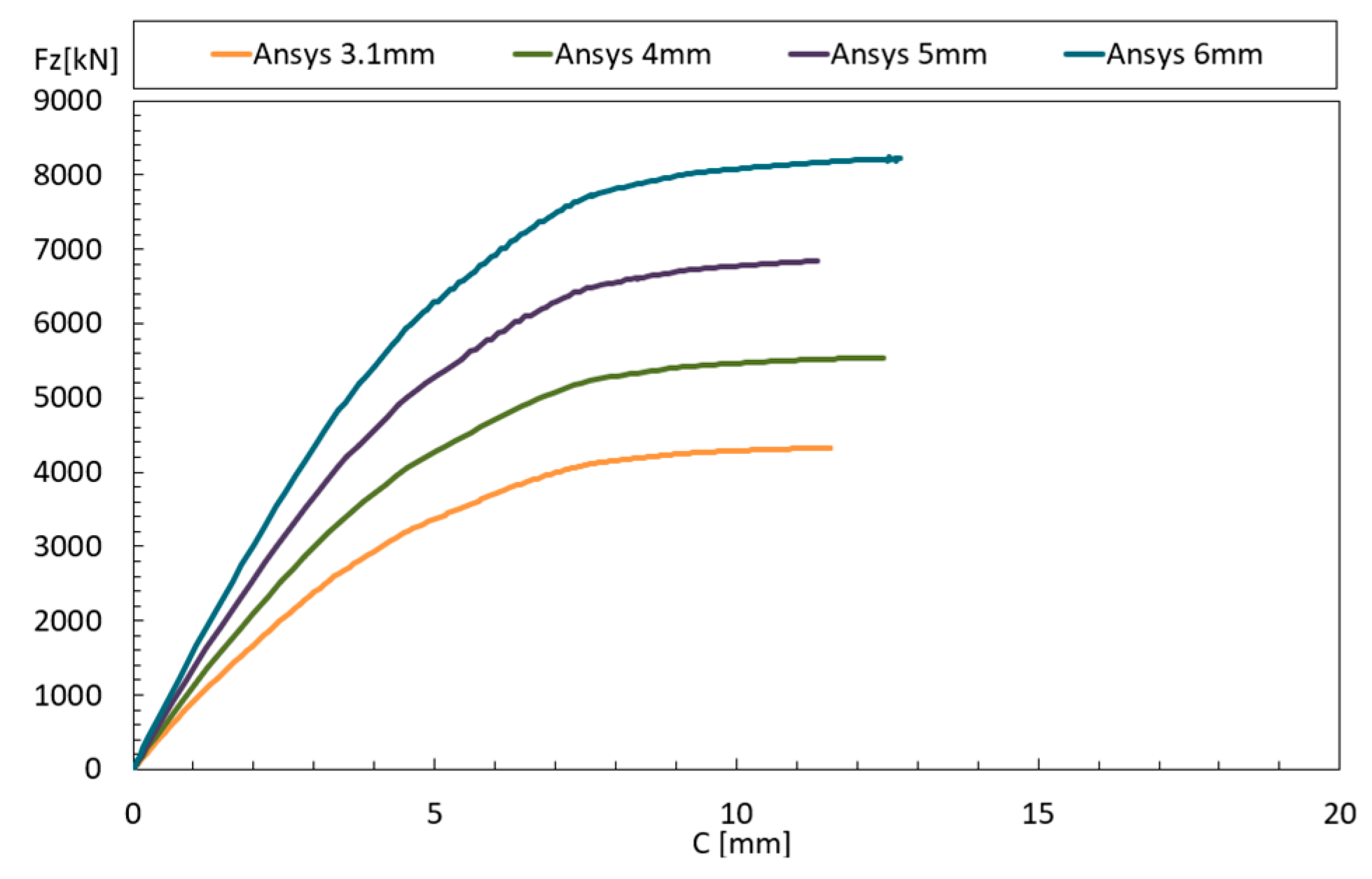
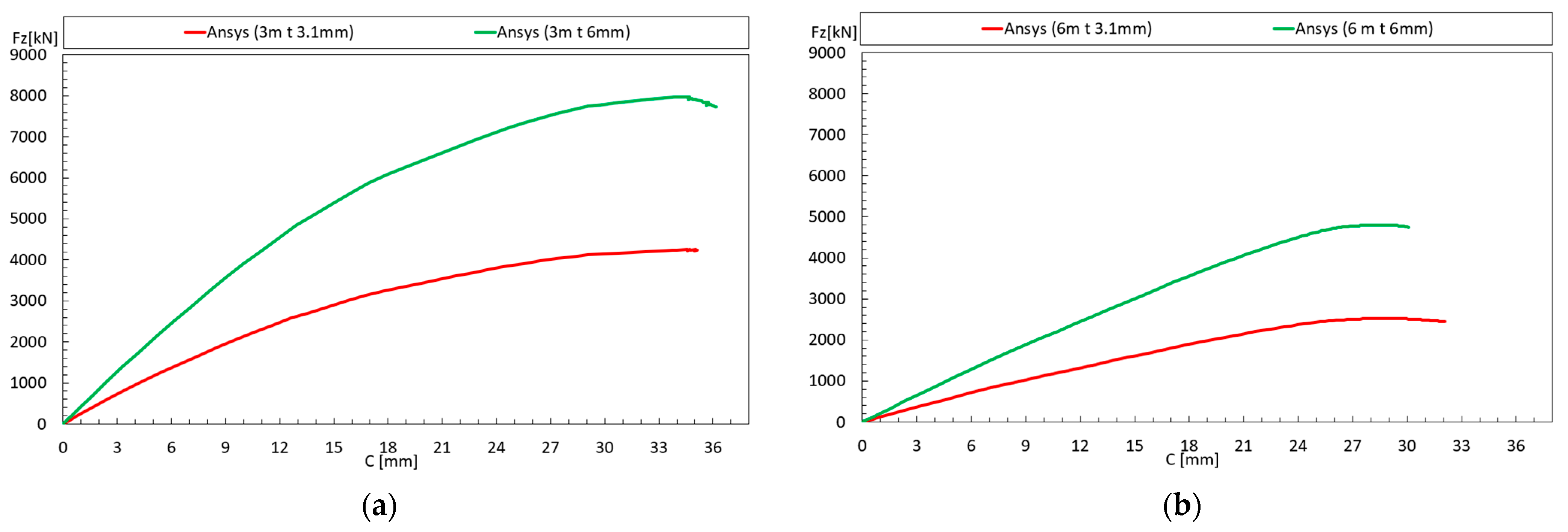
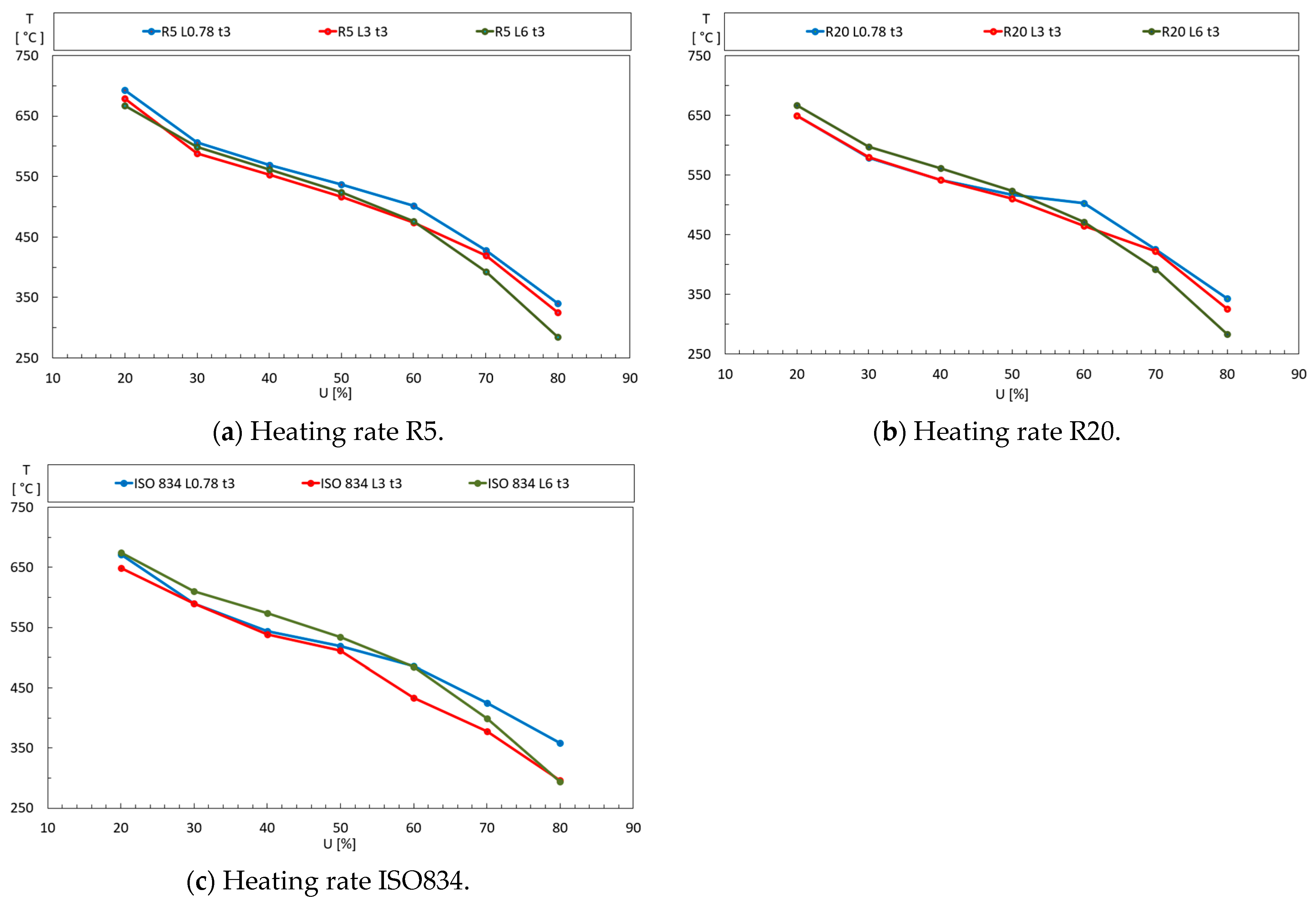

| Element | C | Si | Mn | P | S | Cr | Ni | Mo | B |
|---|---|---|---|---|---|---|---|---|---|
| Content (%) | 0.230 | 0.800 | 1.700 | 0.025 | 0.015 | 1.500 | 1.000 | 0.500 | 0.005 |
| 198 | 1200 | 1375 |
| 193 | 250 | 315 |
| Temperature of Steel T [°C] | Thermal Conductivity λa (W/(m × K)) |
|---|---|
| 20 [°C] < T < 800 [°C] | |
| 800 [°C] ≤ T ≤ 1200 [°C] | 27.3 |
| Temperature of Steel T [°C] | (J/(kg × K)) |
|---|---|
| 20 [°C] < T < 600 [°C] | |
| 600 [°C] ≤ T ≤ 735 [°C] | |
| 735 [°C] ≤ T ≤ 900 [°C] | |
| 900 [°C] ≤ T ≤ 1200 [°C] | 650 |
| Specimen | Load Level (%) | Load-Bearing Capacity (kN) | Load (kN) | Critical Temperature R20 (°C) | Critical Temperature R5 (°C) |
|---|---|---|---|---|---|
| U0.25 | 936 | 234 | 641 | 617 | |
| U0.50 | 936 | 468 | 553 | 522 | |
| U0.75 | 936 | 702 | 454 | 431 |
| Time [s] | Force (N) |
|---|---|
| 0 | |
| 10 | Fz |
| Fz |
| Specimen | Load Level (%) | Load-Bearing Capacity (kN) | Load (kN) | Critical Temperature Ansys (°C) | Relative ERROR (%) | RMSE (mm) |
|---|---|---|---|---|---|---|
| U0.25 | 917.9 | 229.47 | 627.3 | −2.13 | 1.08 | |
| U0.50 | 917.9 | 458.95 | 521.8 | −5.64 | 0.35 | |
| U0.75 | 917.9 | 688.43 | 402.1 | −11.43 | 0.31 |
| Specimen | Load Level (%) | Load-Bearing Capacity (kN) | Load (kN) | Critical Temperature Ansys (°C) | Relative ERROR (%) | RMSE (mm) |
|---|---|---|---|---|---|---|
| U0.25 | 917.9 | 229.47 | 650.2 | 5.37 | 2.15 | |
| U0.50 | 917.9 | 458.95 | 538.4 | 3.14 | 0.81 | |
| U0.75 | 917.9 | 688.43 | 407.4 | −5.47 | 0.49 |
| Specimen | Load Level (%) | Load-Bearing Capacity (kN) | Load (kN) | Critical Temperature R20 (°C) | Critical Temperature R5 (°C) |
|---|---|---|---|---|---|
| U0.30 | 4120 | 1236 | 626 | 604 | |
| U0.45 | 4120 | 1854 | 571 | 537 | |
| U0.60 | 4120 | 2472 | 551 | 483 |
| Specimen | Load Level (%) | Load-Bearing Capacity (kN) | Load (kN) | Critical Temperature Ansys (°C) | Relative ERROR (%) | RMSE (mm) |
|---|---|---|---|---|---|---|
| U0.30 | 1298.52 | 1298.52 | 579.4 | 0.38 | 1.95 | |
| U0.45 | 1947.78 | 1947.78 | 527.9 | 2.91 | 2.61 | |
| U0.60 | 2597.04 | 2597.04 | 503.2 | 3.76 | 0.92 |
| Specimen | Load Level (%) | Load-Bearing Capacity (kN) | Load (kN) | Critical Temperature Ansys (°C) | Relative ERROR (%) | RMSE (mm) |
|---|---|---|---|---|---|---|
| U0.30 | 1298.52 | 1298.52 | 606.3 | −7.44 | 0.96 | |
| U0.45 | 1947.78 | 1947.78 | 552.6 | −7.55 | 0.79 | |
| U0.60 | 2597.04 | 2597.04 | 501.2 | −1.53 | 0.40 |
| Length [m] | Thickness [m] | Heating Rate [°C/min] | Load Level [%] | Simulations |
|---|---|---|---|---|
| 0.78/3.0/6.0 | R5/R20/ISO 834 | 20/30/40/50/60/70/80 | 126 |
| Specimen | Length [m] | Thickness [m] | Slenderness |
|---|---|---|---|
| L0.78 t3.1 | 3.1 | 15.1 | |
| L0.78 t6 | 6 | 15.7 | |
| L3 t3.1 | 3.1 | 58.1 | |
| L3 t6 | 3 | 6 | 60.3 |
| L6 t3.1 | 6 | 3.1 | 116.1 |
| L6 t6 | 6 | 6 | 120.6 |
| Length [m] | Thickness of Tube [m] | Heating Rate [°C/min] | Load Level [%] | Simulations |
|---|---|---|---|---|
| 0.78/3.0/6.0 | R5/R20/ISO 834 | 20/30/40/50/60/70/80 | 126 |
| Specimen | Length [m] | Thickness [m] | Slenderness |
|---|---|---|---|
| L0.78 t3.1 | 3.1 | 4.55 | |
| L0.78 t6 | 6 | 4.71 | |
| L3 t3.1 | 3.1 | 17.49 | |
| L3 t6 | 3 | 6 | 18.12 |
| L6 t3.1 | 6 | 3.1 | 34.98 |
| L6 t6 | 6 | 6 | 36.24 |
| Length [m] | Thickness [mm] | Design Equation |
|---|---|---|
| 3.1 | ||
| 6 | ||
| 3.1 | ||
| 3 | 6 | |
| 6 | 3.1 | |
| 6 | 6 |
| Length [m] | Thickness [m] | Design Equation |
|---|---|---|
| 3.1 | ||
| 6 | ||
| 3.1 | ||
| 3 | 6 | |
| 6 | 3.1 | |
| 6 | 6 |
Disclaimer/Publisher’s Note: The statements, opinions and data contained in all publications are solely those of the individual author(s) and contributor(s) and not of MDPI and/or the editor(s). MDPI and/or the editor(s) disclaim responsibility for any injury to people or property resulting from any ideas, methods, instructions or products referred to in the content. |
© 2024 by the authors. Licensee MDPI, Basel, Switzerland. This article is an open access article distributed under the terms and conditions of the Creative Commons Attribution (CC BY) license (https://creativecommons.org/licenses/by/4.0/).
Share and Cite
Piloto, P.A.G.; Pereira, A.S.; Mottin, A.C. Fire Resistance of Ultra-High-Strength Steel Columns Using Different Heating Rates. Appl. Sci. 2024, 14, 4887. https://doi.org/10.3390/app14114887
Piloto PAG, Pereira AS, Mottin AC. Fire Resistance of Ultra-High-Strength Steel Columns Using Different Heating Rates. Applied Sciences. 2024; 14(11):4887. https://doi.org/10.3390/app14114887
Chicago/Turabian StylePiloto, Paulo A. G., Arthur Silva Pereira, and Artur Caron Mottin. 2024. "Fire Resistance of Ultra-High-Strength Steel Columns Using Different Heating Rates" Applied Sciences 14, no. 11: 4887. https://doi.org/10.3390/app14114887
APA StylePiloto, P. A. G., Pereira, A. S., & Mottin, A. C. (2024). Fire Resistance of Ultra-High-Strength Steel Columns Using Different Heating Rates. Applied Sciences, 14(11), 4887. https://doi.org/10.3390/app14114887







